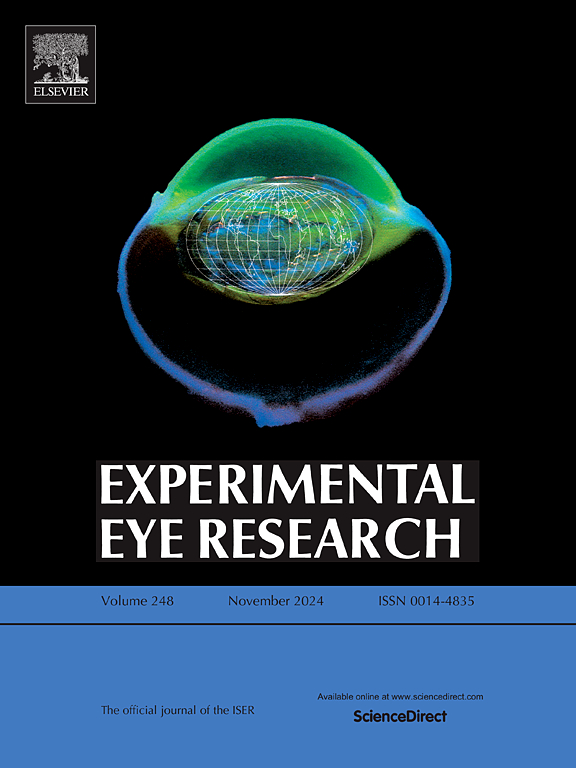Differential analysis of core complement components expression and localization across rodent, non-human primate, and human ocular tissues
IF 3
2区 医学
Q1 OPHTHALMOLOGY
引用次数: 0
Abstract
Age-related macular degeneration (AMD) is a leading cause of blindness. Genetic and pathophysiological studies have implicated that complement pathway dysfunction is a key contributor to progressive vision loss in AMD. Though the association between complement and AMD is recognized, numerous anti-complement therapeutics that had been tested in rodent model systems had limited success in clinical trials. Understanding complement factor production and site of action in ocular pathophysiology is critical for the development of efficacious therapeutics. However, our limited understanding of how these aspects of complement biology vary across species restricts our ability to predict clinical outcomes from studies using animal models. Here, we integrated transcriptomic and immunohistochemical assays to understand the expression and localization of core complement components (complement factor H (FH), complement 3 (C3), and complement 5 (C5)) between ocular tissues of rodent, non-human primate, and human species. We found that complement distribution varied significantly across the studied species, with the most striking differences observed in the FH. While rodents expressed Cfh, an alternative pathway inhibitor, mainly in the RPE, CFH expression in primate eyes was primarily confined to the choroid. These differences were consistent at the protein level, with rodent FH localized in the RPE and primate FH within the choriocapillaris, choroid and sclera. Regarding C5, a terminal complement pathway component, we observed minimal ocular mRNA levels in all three species. However, we observed detectable protein levels in the RPE in rodents and the choroid in humans. Next, C3 mRNA transcripts and C3 protein exhibited similar distribution in the choroid in both rodent and primate eyes. Together, our findings highlight key differences and similarities between rodent and primate complement biology that may offer insights into the translatability of animal models and inform the design of effective therapeutics.
核心补体成分在啮齿动物、非人类灵长类动物和人类眼部组织中的表达和定位差异分析。
年龄相关性黄斑变性(AMD)是导致失明的主要原因。遗传和病理生理研究表明,补体通路功能障碍是AMD患者进行性视力丧失的关键因素。虽然补体和AMD之间的联系是公认的,但在啮齿动物模型系统中测试的许多抗补体疗法在临床试验中取得的成功有限。了解补体因子的产生及其在眼病理生理中的作用位点对于开发有效的治疗方法至关重要。然而,我们对补体生物学的这些方面如何在物种间变化的理解有限,限制了我们通过动物模型研究预测临床结果的能力。本研究结合转录组学和免疫组化分析,了解核心补体成分(补体因子H (FH)、补体3 (C3)和补体5 (C5))在啮齿类动物、非人灵长类动物和人类眼部组织中的表达和定位。我们发现,补体分布在研究物种之间差异很大,在FH中观察到最显著的差异。啮齿类动物主要在RPE中表达Cfh,而灵长类动物的Cfh表达主要局限于脉络膜。这些差异在蛋白水平上是一致的,啮齿动物的FH定位于RPE,而灵长类动物的FH定位于绒毛膜、脉络膜和巩膜。关于C5,一个终末补体通路成分,我们观察到所有三个物种的眼部mRNA水平都很低。然而,我们在啮齿动物的RPE和人类的脉络膜中观察到可检测的蛋白质水平。接下来,C3 mRNA转录物和C3蛋白在啮齿类动物和灵长类动物眼睛的脉络膜中表现出相似的分布。总之,我们的研究结果突出了啮齿动物和灵长类动物补体生物学之间的关键差异和相似之处,这可能为动物模型的可翻译性提供见解,并为有效治疗的设计提供信息。
本文章由计算机程序翻译,如有差异,请以英文原文为准。
求助全文
约1分钟内获得全文
求助全文
来源期刊

Experimental eye research
医学-眼科学
CiteScore
6.80
自引率
5.90%
发文量
323
审稿时长
66 days
期刊介绍:
The primary goal of Experimental Eye Research is to publish original research papers on all aspects of experimental biology of the eye and ocular tissues that seek to define the mechanisms of normal function and/or disease. Studies of ocular tissues that encompass the disciplines of cell biology, developmental biology, genetics, molecular biology, physiology, biochemistry, biophysics, immunology or microbiology are most welcomed. Manuscripts that are purely clinical or in a surgical area of ophthalmology are not appropriate for submission to Experimental Eye Research and if received will be returned without review.
 求助内容:
求助内容: 应助结果提醒方式:
应助结果提醒方式:


